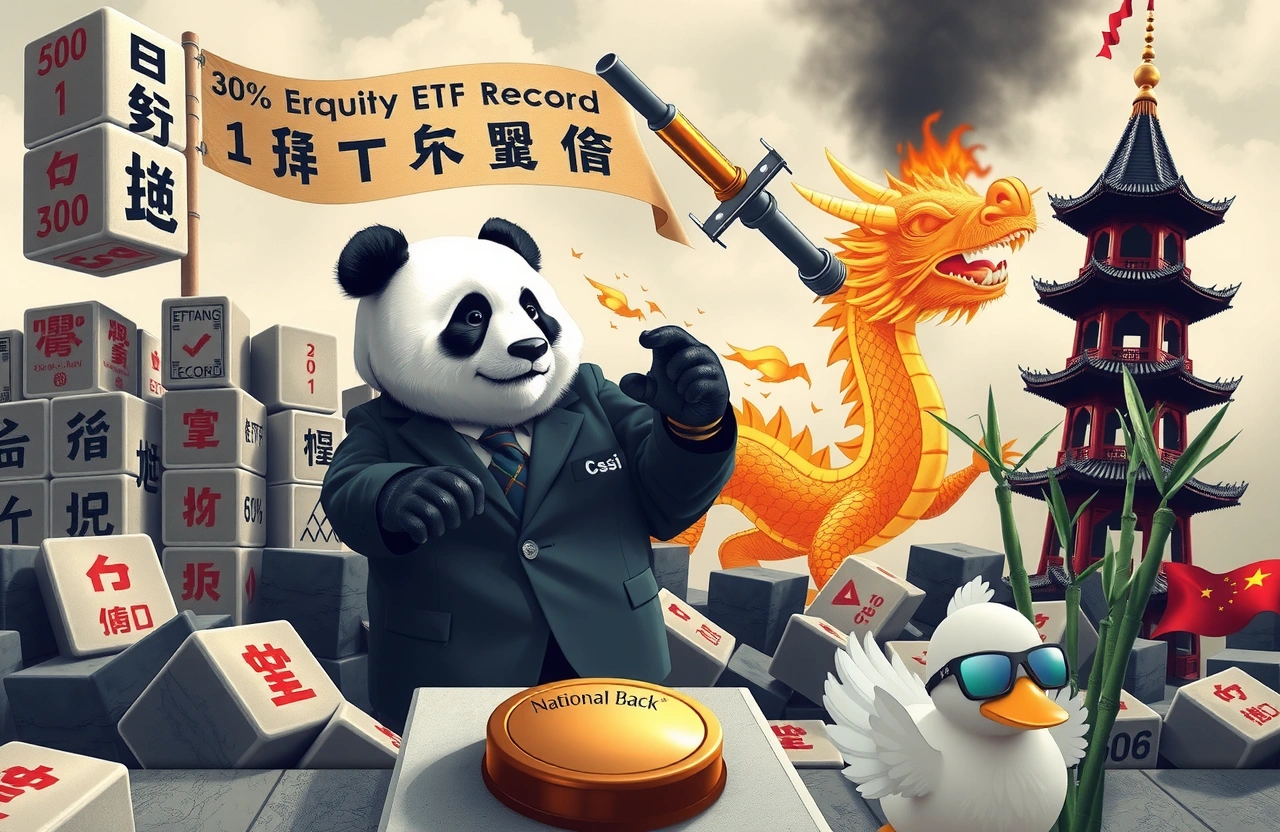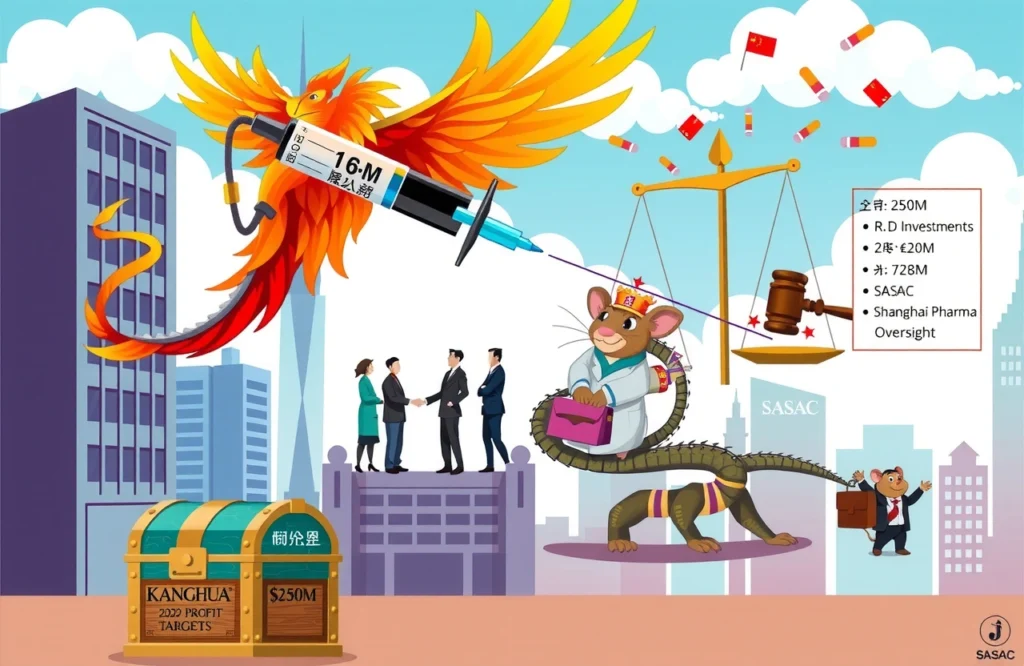Key developments:
– Central Huijin deployed over 1.7 trillion yuan ($240 billion) across 6 flagship ETFs during April’s market crisis
– State-backed intervention reversed steep April declines, fueling Q2 market recovery
– ETF purchases now comprise over 40% positions in core funds like ChinaAMC’s SSE 50 ETF
– Market stabilization mechanism functioning as quasi-sovereign wealth fund
– Asset injections push total equity ETF values to record 3.1 trillion yuan
Emergency Market Intervention During April Turmoil
When Chinese equities plummeted unexpectedly this April, Beijing’s financial guardians mobilized with military precision. Dubbed the ‘National Team’ (国家队), this coalition of state-backed institutions executed the largest exchange-traded fund rescue operation in China’s capital market history. Public disclosures from July quarterly reports reveal Central Huijin Asset Management – the investment arm of China’s sovereign wealth fund – deployed 1.7 trillion yuan ($240 billion) across six cornerstone ETFs between April and June. This decisive action transformed what began as a catastrophic decline into the foundation for Q2’s market resurgence.
The Anatomy of Crisis: Understanding April’s Slide
Throughout early 2025, China’s equity markets maintained relative stability despite economic headwinds. This equilibrium shattered on April 7th when several unforeseen triggers converged:
– Manufacturing PMI unexpectedly contracted to 48.7
– Property sector bond defaults spiked 22% year-over-year
– Export restrictions imposed on critical minerals
– Offshore yuan depreciation accelerated
The CSI 300 Index hemorrhaged 8.3% during the fortnight beginning April 7th. Trading volumes in blue-chip ETFs surged to unprecedented levels, with HuaTai-Pinebridge’s CSI 300 ETF alone processing $4.2 billion daily – a clear distress signal that prompted state intervention.
Unveiling the National Team’s Tactical Playbook
China’s National Team intervention represents a sophisticated market stabilization strategy refined through multiple cycles since its inaugural 2008 deployment. Unlike Western-style bailouts, China’s approach harnesses concentrated purchases in broad-market ETFs to establish price floors while bypassing individual equities. As Goldman Sachs China strategist Michael Lu explained: “This acts like hydraulic stabilizers beneath the entire market ecosystem rather than inflating specific sectors.”
Core Holdings Deployment Breakdown
Bleed-stopping occurred through deliberate targeting of liquidity-rich ETFs described as “pillars of legitimacy” by stock exchange sources:
| Fund | Huijin Holdings (Q2) | Purchase Value | Market Share |
|---|---|---|---|
| ChinaAMC CSI 300 ETF | 357.5 billion yuan | 92.88B shares | 43.97% |
| E Fund CSI 300 ETF | 312.04 billion yuan | 84.29B shares | 41.71% |
| HuaTai-Pinebridge CSI 300 ETF | 422.12 billion yuan | 108.74B shares | 37.91% |
| Harvest CSI 500 ETF | 215.83 billion yuan | 55.4B shares | 38.69% |
| ChinaAMC SSE 50 ETF | 222.23 billion yuan | Not Disclosed | 46% |
| China Southern CSI 500 ETF | 189.09 billion yuan | Not Disclosed | 39% |
Remarkably, 70% of capital deployment occurred during April’s trough, achieving maximum psychological impact. Central Huijin leveraged its advantage as perpetual buyer – insulated from redemption pressures – to absorb waves of panic selling.
The Stabilization Sequence
The market stabilization sequence unfolded with orchestrated precision:
- Identification of contagion vectors spreading across index futures
- Constructing liquidity buffers via SOE banks and policy insurers
- Coordinated volume surges timed to break negative momentum
- Establishing psychological price ceilings using derivatives
- Proportional withdrawal as normalcy returned
Anatomy of Market Stabilization Mechanics
This latest intervention validates the National Team’s evolution into a sophisticated market stabilization apparatus functioning similar to Singapore’s Temasek model. Rather than distorting price discovery, the strategy reinforces structural foundations – evident in how April’s crash trajectory abruptly reversed after key thresholds were defended.
The Pivot Function Explained
Critical thresholds where interventions occurred:
– CSI 300: Defended at 3,350 support level
– SSE Composite: Critical psychological 2,800 barrier maintained
– CSI Smallcap 500: 5,400 platform preserved
These baselines weren’t arbitrarily selected. Trading algorithms recognize these zones as infrastructure stabilizer engagement points, creating self-reinforcing consensus. Dr. Zhang Qiang, Shanghai Finance University professor, notes: “The signal function often proves more powerful than actual capital deployed once credibility is established.”
Beyond Cash: Stabilization Signaling
The National Team utilizes layered communication:
– Formal statements reaffirming long-term commitment
– Trading-quantity disclosures building trust
– Visible coordination with monetary policymakers
– “Hotline†reactions to volatility index spikes
This scaffolding transforms reactive intervention into proactive stability architecture. Quietly, National Team units now hold permanent desks at Shanghai and Shenzhen exchanges – embedding stabilization capabilities within market infrastructure.
Historical Precedents and Evolution
This episode builds upon sophisticated crisis response capabilities honed over 17 years:
Crisis Governance Milestones
| Event | Intervention Scale | Mechanism | Outcome |
|---|---|---|---|
| 2008 Global Crisis | $110 billion | Direct share purchases | Partial effectiveness |
| 2015 “Circuit Breaker†Crisis | $200 billion | ETF pilot program | Mixed results |
| 2020 Pandemic Shock | $300 billion | Coordinated SOE buying | Successful rebound |
| 2023 Property Contagion | $185 billion | Sector-specific ETFs | Contained spillover |
| 2025 Current Operation | $240 billion | Algorithmic index defense | Most efficient to date |
Each episode refined coordination protocols between the People’s Bank of China, Ministry of Finance, and CSRC – shortening intervention latency to under 72 hours for April’s activation. Advanced stabilization platforms now monitor real-time capital flows across 137 indicators, enabling preemptive adjustments.
Market Response: Reversal and Recovery Analysis
Immediate market stabilization outcomes highlight the effectiveness:
Recovery Metrics
– CSI 300 reversal: 23% recovery April-June
– Trading volume normalisation: 11 days
– Capital flight reduction: $7.9 billion stemmed
– Volatility compression: VIX equivalent declined 42%
Broader macroeconomic dividends emerged within weeks:
– Corporate bond issuance revived
– IPO pipeline reactivated
– Margin debt stabilized
– Currency stability returned
By June’s close, equity ETFs swelled to record 3.1 trillion yuan ($436 billion) total assets – validating strong retail participation anchoring the recovery.
The Road Ahead: Structural Implications
Beyond restoring calm, April’s intervention reveals emerging architecture for China’s financial stability regime:
Future Evolution
Policy indications suggest stabilization mechanisms will evolve:
– Formalizing ETF stabilization as primary lever
– Developing counter-cyclical buffer frameworks
– Integrating circuit-breaker refinements
– Expanding coordination with HK and offshore markets
Important meta-trend: Retail investors increasingly perceive ETF vehicles as de facto stabilization instruments – accelerating China’s transition toward institutional investment culture.
Sustainability Questions
Challenges demanding solutions:
– Scalability constraints beyond blue-chip indices
– Corporate governance impacts
– Moral hazard calibration
– Integration with pension reforms
Long-term evolution might follow Temasek’s model transitioning toward proper sovereign stabilization fund with professional boards – a policy debate gaining urgency following April’s action blueprint.
Global Context: Comparative Stabilization Strategies
China’s approach offers contrasts and convergences with international peers:
Sovereign Intervention Spectrum
| Country | Primary Stabilization Tool | Crisis Response Timing | Accountability Mechanism |
|---|---|---|---|
| China | Strategic ETF Accumulation | Preemptive/Dynamic | Limited Transparency |
| United States | Fed Liquidity Facilities | Reactive | Congressional Oversight |
| Japan | BOJ ETF Purchases | Structural/Continuous | Central Bank Independence |
| Switzerland | National Bank Equity Holdings | Opportunistic | Public Referendum |
| Singapore | Temasek Portfolio Adjustments | Counter-Cyclical | Sovereign Fund Protocols |
Beijing’s model demonstrates unique advantages:
– Rapid deployment capability
– Index-level precision
– Political authorization continuity
The operational maturity revealed in Q2 suggests China’s stabilization toolbox now rivals advanced economies despite its developmental context.
Conclusion: Toward Mature Capital Market Governance
The National Team’s sector-shaking intervention achieves more than arresting April’s slide – it demonstrates sophisticated crisis containment protocols deserving investor confidence. Visible application throughout Q2 now indelibly reshapes market psychology:
– State backing creates structural security
– ETF channels enable efficient stabilization
– Credibility compounds with precise execution
The National Team’s decisive action transcended immediate market stabilization – it signals China’s evolution toward institutionalized mechanisms preserving market functionality amid volatility. Investors should monitor Central Huijin disclosures for signals about emerging stabilization thresholds while policymakers translate this blueprint into permanent architecture.
Vigilance remains essential: Forward-looking investors should routinely examine ETF position disclosures as “National Team†orientation gauges and advocate transparent stabilization fund frameworks. China’s markets emerging intact from April’s crucible deserves recognition – the stewardship demonstrated reflects considerable institutional maturation.




